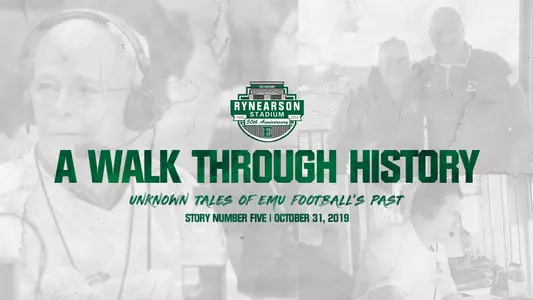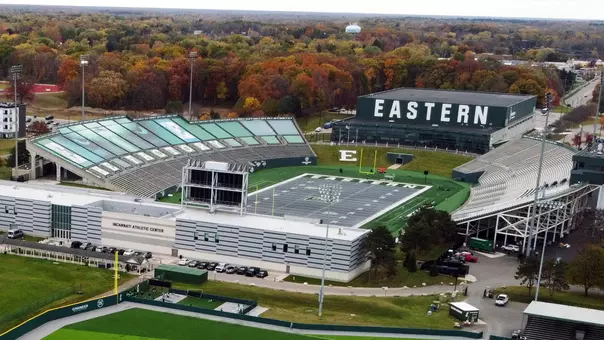Eastern Michigan Athletics

A Walk Through History: They Called the Action
10/31/2019 12:56:00 PM | Football, General
Author T.C. Cameron tells unknown tales from EMU Football's Past
Celebrating Rynearson Stadium's 50th anniversary requires a few tales from those who told the story every Saturday from the broadcast booth.
Sans a handful of one-offs, the list of play-by-play broadcasters who brought the action alive from the field is remarkably short and incredibly accomplished.
John Fountain and Matt Shepard span more than six decades of EMU football. The majority of that time belongs to Fountain, who already had two decades of play-by-play behind him when Shepard was quarterback in the early 1980s at North Farmington High School.
Fountain is Eastern Michigan's Ernie Harwell, his on-air delivery simple and stately, a perfect match to his off-air demeanor. He started broadcasting EMU in 1963, from the booth at Rynearson or a court side seat at Bowen Field House and later, the Convocation Center. Fountain also called Michigan football for a few seasons in the 1960s. He retired from football in 2001 and basketball in 2007.
Fountain began broadcasting when EMU still played football on the main campus, and he was old school in every way. He never gave the score often enough for you to tune in and out. Unlike some who describe the action with the pace and tone of a carnival barker, his strength was in a seemingly effortless cadence. He knew when to be quiet, allowing the shrill of the crowd, the thunder of a canon or the energizing blasts of a marching band take over. The scene surrounding the broadcast booth was always more than wallpaper. Even his call sign when going to a commercial break or signing off, "This is EMU Football…" was simple, graceful.
Football's rhythm is a little like bowling — set the pins, throw the ball, knock the pins over, put them back up and call it second down — but the break-neck pace of substitutions has made the broadcaster's job more challenging.
"When I started, the players in the starting lineup hardly ever changed, so your spotter only tapped you on the shoulder when someone new entered the game," Fountain said. "When I left the booth, there were three new players coming in on every play, or a whole new package of receivers. Player identification takes an awful lot of time today."
Fountain preceded Jim Streeter as EMU's sports information director from 1966-1975. He was also interim athletic director in 1974 and for many years in the 1980s, vice-president for university relations and secretary for the Board of Regents.
All of this was in addition to broadcasting football and basketball; he was inducted into the E-Club Hall of Fame in 1996.
"One of my career highlights was 1984, the Eastern Energy year. We had a long losing streak hanging over us and started out 0-4, but tied twice and won twice in the last seven games," Fountain said. "The 16-16 tie against Central Michigan, when Mario Ferretti kicked a field goal in the final seconds, was the turning point for the program and a moment that married the big crowds we were getting to the team."
Fountain was also at the mic when Eastern authored the ultimate revenge tour, defeating every school in 1987 that voted against them in 1984's MAC removal vote, then winning the California Bowl.
Shepard started calling EMU games in 1999. He's often described as the hardest-working man in Detroit broadcast media. He molded himself into one of the most versatile broadcasters in the country, bouncing from station to station, and sport to sport, until he earned the television play-by-play job for the Detroit Tigers in 2019.
Most assumed EMU would be in the market for a new broadcaster in 2019, including EMU coach Chris Creighton.
"Coach Creighton sent me a game ball from the bowl game last year, thinking I'd called my last game. It meant an awful lot to me," Shepard said, "but it turned out my bosses at Fox Sports Detroit wanted me to continue doing EMU football. They love it."
This season, Tom Helmer joined the fray, splitting play-by-play duties with Shepard while also calling Boston Red Sox games for the New England Sports Network (NESN). Helmer famously called Matthew Sexton's blocked punt for a touchdown to defeat Central Connecticut State with 10 seconds left from his iPhone. He and Shepard are part of a fraternity of seven broadcasters in 2019 who are calling major league baseball and NCAA football at the FBS level.
Shepard took over I the play-by-play duties in 1999, pairing with Rob Rubick, a tight end with the Lions who grew up in Newberry in Michigan's Upper Peninsula. In 2000, Fountain returned when Shepard was let go due to unintentional miscommunication between EMU's athletic department and WEMU.
"Some of the school's former leadership wanted take the broadcast in a different direction and wanted me to lead that way, but what I didn't know was they hadn't consulted with the folks at WEMU, who had put their heart and soul into it for so many years," said Shepard. He downplays the entire situation as little more than a hiccup.
So for one season, it was Fountain and Rubick, who played for Jim Harkema at Grand Valley State University and worked Harkema's EMU football camps in the 1980s.
"Broadcasting with John was like calling a game with your grandfather," Rubick said. "He was so even keel because there was very little he hadn't seen before."
Except at the 2000 Toledo game, when Fountain could hardly see anything at the Glass Bowl.
"If you've ever been there, you know the press box goes straight up. It was a night game, and just after kickoff, a dense fog covered the field," Rubick said. "It was a thick blanket that we couldn't see through, except from the nearside hashmark to the sideline closest to the press box. We went to a break and John is upset. He can't see and he's beside himself. So I tell him to just wing it. Make it up and when they put the runner's number and the yardage he gained on the scoreboard, just fill it in. John wasn't having it."
Today, the EMU program Shepard and Rubick see, on the field and from a facility standpoint, looks nothing like it when they started.
"Everything is different, from the commitment from administration to the type of player they recruiting," Shepard said. "I remember being on the field with Rubes at Vanderbilt, seeing four of their tights ends and saying to each other, 'We don't have anyone on our roster like that.' Now we've got big-body fast guys at every position who everyone looks at and says, 'That guy could be an All-MAC player.' Now we expect Eastern to win … When we left Kentucky a few years ago, we were the better team."
That was never more true than last season at Purdue. Forced to park miles away from Ross-Ade Stadium, the courtesy shuttle to the press box was filled with condescending small talk — "'You guys have a nice little program,' would be a polite description of how we were spoken to," Rubick says — but all that changed when Chad Ryland booted a 25-yard field goal on the final play to lift Eastern to a 20-19 win, the Eagles' second-straight win over a Big Ten school in as many years.
"We're walking out of the booth, our heads held high, but no one will make eye contact," Rubick said. "They were mad, and they wouldn't get us a shuttle back to our car. Shep was losing his mind."
Like fans who plan their weekends around football, with tailgates and season tickets, Shepard and Rubick are best friends, sharing the long drives and meals before and after games together. Along the way, they've learned a lot about each other.
"When we started broadcasting EMU, it wasn't uncommon to be facing a 30 or 40-point deficit in the fourth quarter, so Shep had a handful of stories to fall back on," Rubick says. "We hit a dead spot one night and I say, 'When T.J. Lang was 13, he went on a hunting trip to Alpena and shot an 8-point buck on his first shot.'"
"We go to break and Shep asks, 'Where did you get that story?' When I told him I made it up, he lost it," Rubick continued. "He gave me a pretty stern lecture, and explained that's not how we do things in this business."
Shepard remembers the moment well — "It's one of just two times we've ever had a difficult conversation" — but recognizes Rubick's innate ability to connect with coaches and players, combined with his meticulous preparation (he famously reads each opponent's media guide cover to cover) that make them a perfect 'odd couple' in the booth.
"Every week I fill note pads with stats, facts, figures and anecdotes, and in walks Rubes — we call him 'Shiny Penny' because his attention can be distracted so quickly — with a brief case that's got two highlighters, green for Eastern and yellow for the opponent, depth charts and his glasses," Shepard said. "But he prepares in his own way, so he can walk in and say, 'Who's playing today?' and get it done. It works because his personality is so contagious, and his ability to get information from coaches and players is as unique as it is impressive."
Almost as impressive as having Rubick, a former NFL player, with two major league-caliber broadcasters in Shepard and Helmer, calling games.
"It's no secret I'm fond of Eastern, a really good school with a beautiful campus. They've been very good for a few years now, and they're good again this year," Shepard said. "As long as EMU is willing to have have me back, I'm honored to continue doing it."
— T.C. Cameron is the author of Miracle Maples (2019) and Navy Football: Return to Glory (2017). A 1995 graduate of EMU, he's lived in Annapolis, MD since 2009. Follow him on Twitter: @ByTCCameron
Did you know? MLB and NCAA FBS football broadcasters in 2019
*Kevin Eschenfelder Astros; University of Houston
*Tom Helmer Red Sox; Eastern Michigan University
Ted Leitner Padres; San Diego State
*Matt Lepay Brewers; Wisconsin
*Josh Lewin Red Sox; UCLA
*Pete Medhurst Nationals; Navy
Matt Shepard Tigers; Eastern Michigan University
* - part-time with the MLB club





